Outdoor Environment for Children: Physical Development and Wellbeing
VerifiedAdded on 2022/11/10
|14
|3947
|238
Essay
AI Summary
This essay delves into the critical importance of outdoor environments for children, emphasizing the multifaceted benefits ranging from physical and emotional wellbeing to social and intellectual development. It highlights the historical and contemporary perspectives on outdoor play, acknowledging its decline in modern society due to increased indoor activities. The paper critically examines current approaches and beliefs regarding providing stimulating outdoor environments, while also addressing the potential risks associated with such environments, such as injuries and exposure to the elements. Furthermore, it discusses the value of promoting physical skills, health, and wellbeing through outdoor activities, advocating for the integration of outdoor environments into healthcare and education systems to foster children's holistic growth. The essay underscores the need for safe, age-appropriate outdoor play opportunities and emphasizes the role of caregivers in creating environments that encourage exploration, learning, and social interaction, while mitigating potential hazards and promoting children's confidence and independence.
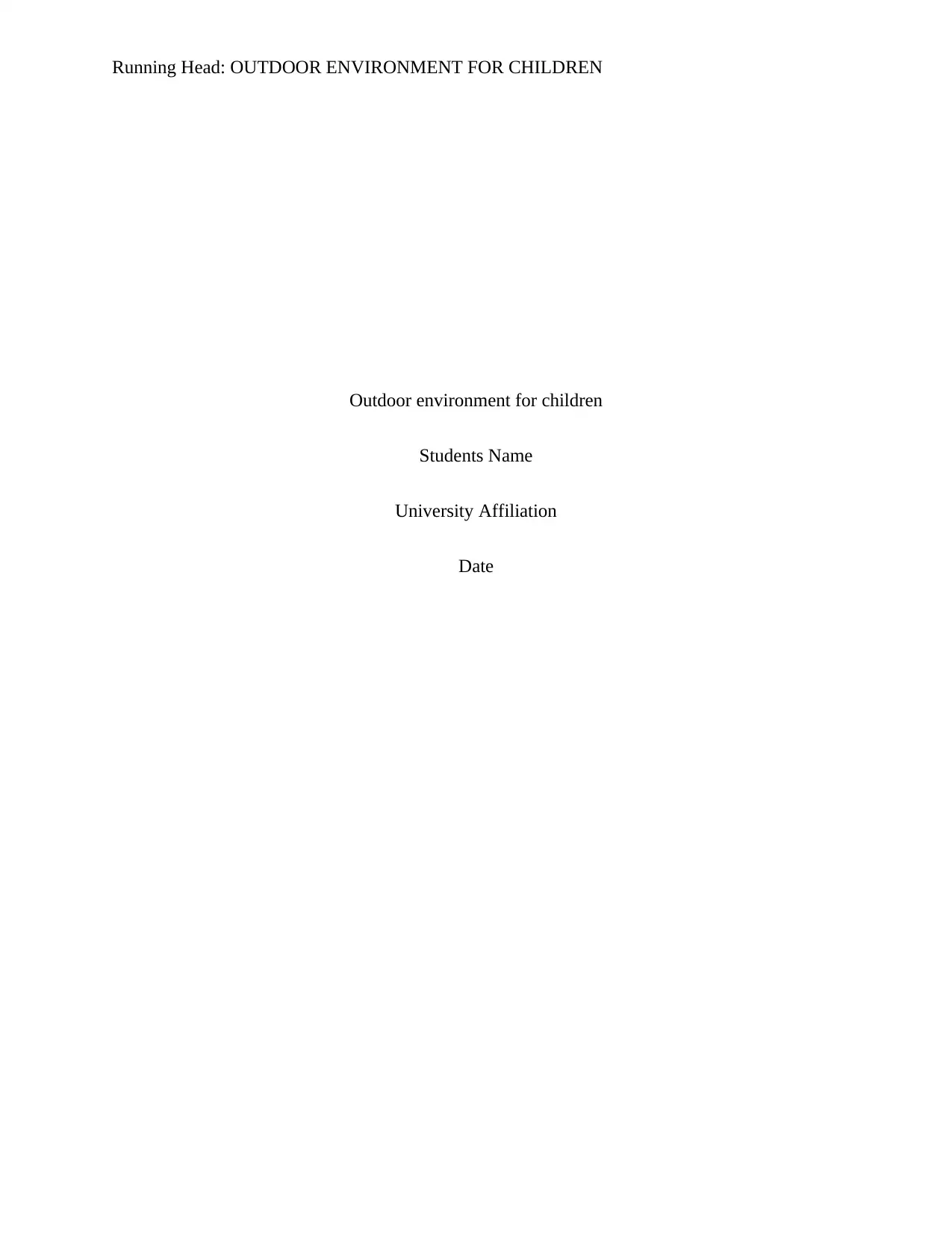
Running Head: OUTDOOR ENVIRONMENT FOR CHILDREN
Outdoor environment for children
Students Name
University Affiliation
Date
Outdoor environment for children
Students Name
University Affiliation
Date
Paraphrase This Document
Need a fresh take? Get an instant paraphrase of this document with our AI Paraphraser
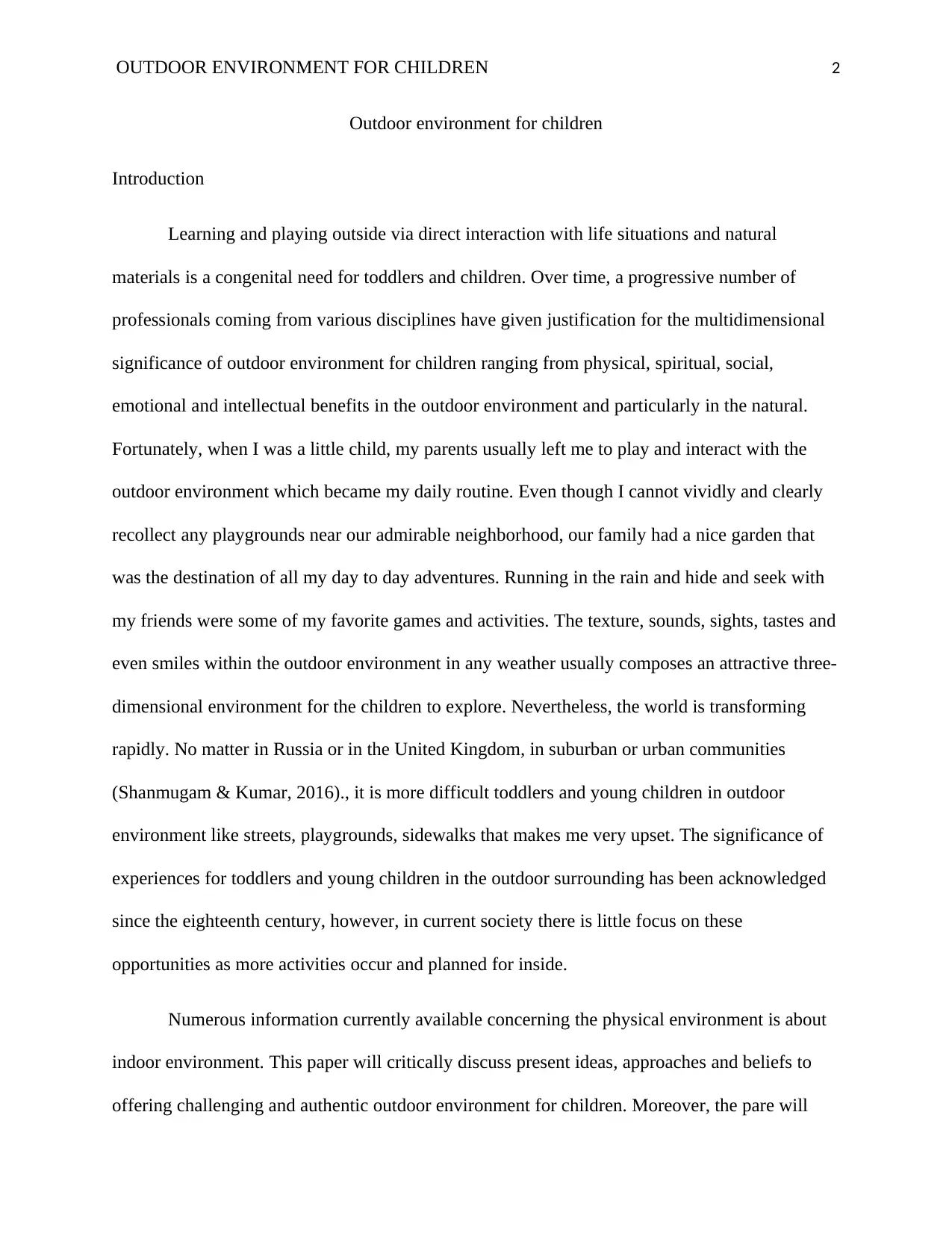
OUTDOOR ENVIRONMENT FOR CHILDREN 2
Outdoor environment for children
Introduction
Learning and playing outside via direct interaction with life situations and natural
materials is a congenital need for toddlers and children. Over time, a progressive number of
professionals coming from various disciplines have given justification for the multidimensional
significance of outdoor environment for children ranging from physical, spiritual, social,
emotional and intellectual benefits in the outdoor environment and particularly in the natural.
Fortunately, when I was a little child, my parents usually left me to play and interact with the
outdoor environment which became my daily routine. Even though I cannot vividly and clearly
recollect any playgrounds near our admirable neighborhood, our family had a nice garden that
was the destination of all my day to day adventures. Running in the rain and hide and seek with
my friends were some of my favorite games and activities. The texture, sounds, sights, tastes and
even smiles within the outdoor environment in any weather usually composes an attractive three-
dimensional environment for the children to explore. Nevertheless, the world is transforming
rapidly. No matter in Russia or in the United Kingdom, in suburban or urban communities
(Shanmugam & Kumar, 2016)., it is more difficult toddlers and young children in outdoor
environment like streets, playgrounds, sidewalks that makes me very upset. The significance of
experiences for toddlers and young children in the outdoor surrounding has been acknowledged
since the eighteenth century, however, in current society there is little focus on these
opportunities as more activities occur and planned for inside.
Numerous information currently available concerning the physical environment is about
indoor environment. This paper will critically discuss present ideas, approaches and beliefs to
offering challenging and authentic outdoor environment for children. Moreover, the pare will
Outdoor environment for children
Introduction
Learning and playing outside via direct interaction with life situations and natural
materials is a congenital need for toddlers and children. Over time, a progressive number of
professionals coming from various disciplines have given justification for the multidimensional
significance of outdoor environment for children ranging from physical, spiritual, social,
emotional and intellectual benefits in the outdoor environment and particularly in the natural.
Fortunately, when I was a little child, my parents usually left me to play and interact with the
outdoor environment which became my daily routine. Even though I cannot vividly and clearly
recollect any playgrounds near our admirable neighborhood, our family had a nice garden that
was the destination of all my day to day adventures. Running in the rain and hide and seek with
my friends were some of my favorite games and activities. The texture, sounds, sights, tastes and
even smiles within the outdoor environment in any weather usually composes an attractive three-
dimensional environment for the children to explore. Nevertheless, the world is transforming
rapidly. No matter in Russia or in the United Kingdom, in suburban or urban communities
(Shanmugam & Kumar, 2016)., it is more difficult toddlers and young children in outdoor
environment like streets, playgrounds, sidewalks that makes me very upset. The significance of
experiences for toddlers and young children in the outdoor surrounding has been acknowledged
since the eighteenth century, however, in current society there is little focus on these
opportunities as more activities occur and planned for inside.
Numerous information currently available concerning the physical environment is about
indoor environment. This paper will critically discuss present ideas, approaches and beliefs to
offering challenging and authentic outdoor environment for children. Moreover, the pare will
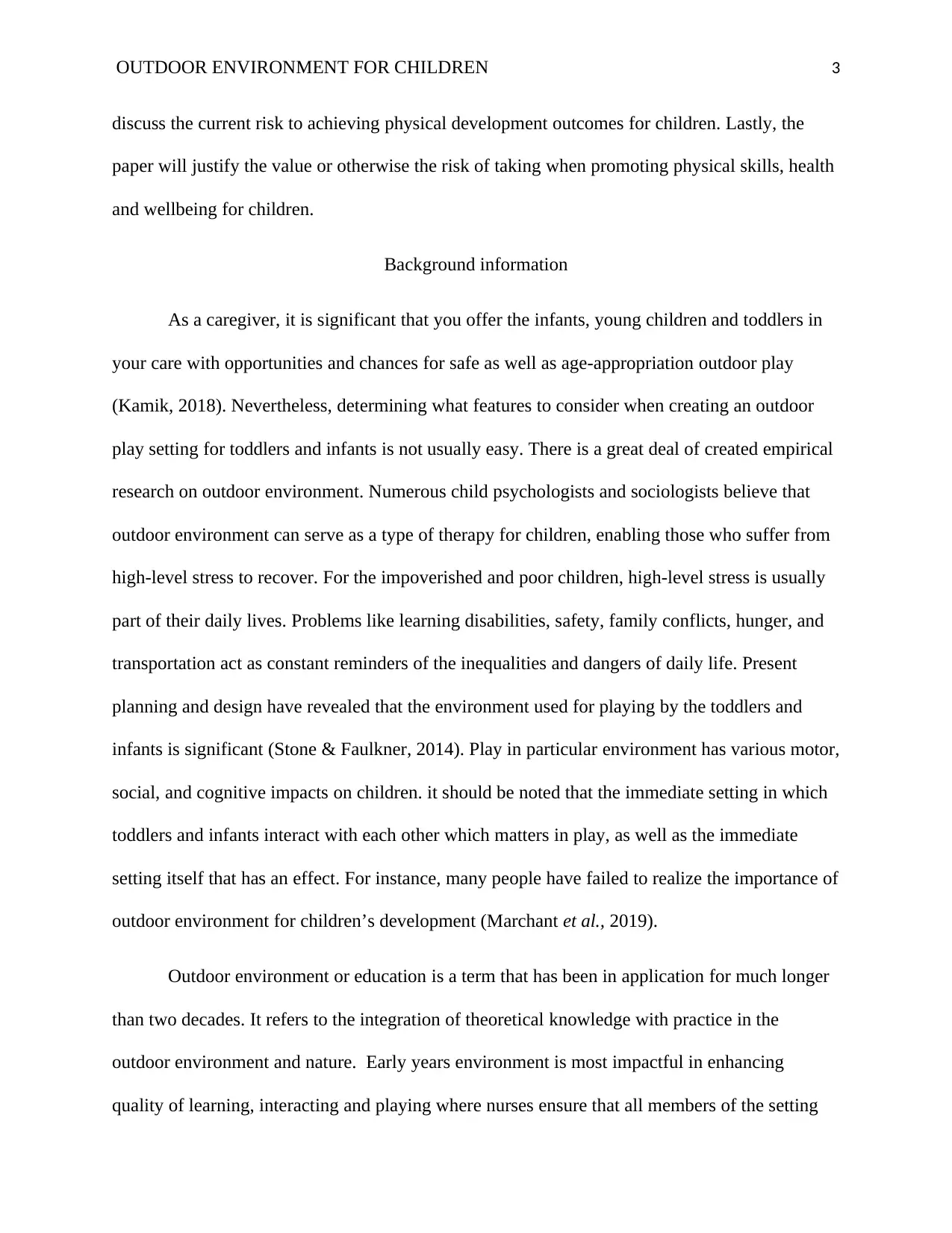
OUTDOOR ENVIRONMENT FOR CHILDREN 3
discuss the current risk to achieving physical development outcomes for children. Lastly, the
paper will justify the value or otherwise the risk of taking when promoting physical skills, health
and wellbeing for children.
Background information
As a caregiver, it is significant that you offer the infants, young children and toddlers in
your care with opportunities and chances for safe as well as age-appropriation outdoor play
(Kamik, 2018). Nevertheless, determining what features to consider when creating an outdoor
play setting for toddlers and infants is not usually easy. There is a great deal of created empirical
research on outdoor environment. Numerous child psychologists and sociologists believe that
outdoor environment can serve as a type of therapy for children, enabling those who suffer from
high-level stress to recover. For the impoverished and poor children, high-level stress is usually
part of their daily lives. Problems like learning disabilities, safety, family conflicts, hunger, and
transportation act as constant reminders of the inequalities and dangers of daily life. Present
planning and design have revealed that the environment used for playing by the toddlers and
infants is significant (Stone & Faulkner, 2014). Play in particular environment has various motor,
social, and cognitive impacts on children. it should be noted that the immediate setting in which
toddlers and infants interact with each other which matters in play, as well as the immediate
setting itself that has an effect. For instance, many people have failed to realize the importance of
outdoor environment for children’s development (Marchant et al., 2019).
Outdoor environment or education is a term that has been in application for much longer
than two decades. It refers to the integration of theoretical knowledge with practice in the
outdoor environment and nature. Early years environment is most impactful in enhancing
quality of learning, interacting and playing where nurses ensure that all members of the setting
discuss the current risk to achieving physical development outcomes for children. Lastly, the
paper will justify the value or otherwise the risk of taking when promoting physical skills, health
and wellbeing for children.
Background information
As a caregiver, it is significant that you offer the infants, young children and toddlers in
your care with opportunities and chances for safe as well as age-appropriation outdoor play
(Kamik, 2018). Nevertheless, determining what features to consider when creating an outdoor
play setting for toddlers and infants is not usually easy. There is a great deal of created empirical
research on outdoor environment. Numerous child psychologists and sociologists believe that
outdoor environment can serve as a type of therapy for children, enabling those who suffer from
high-level stress to recover. For the impoverished and poor children, high-level stress is usually
part of their daily lives. Problems like learning disabilities, safety, family conflicts, hunger, and
transportation act as constant reminders of the inequalities and dangers of daily life. Present
planning and design have revealed that the environment used for playing by the toddlers and
infants is significant (Stone & Faulkner, 2014). Play in particular environment has various motor,
social, and cognitive impacts on children. it should be noted that the immediate setting in which
toddlers and infants interact with each other which matters in play, as well as the immediate
setting itself that has an effect. For instance, many people have failed to realize the importance of
outdoor environment for children’s development (Marchant et al., 2019).
Outdoor environment or education is a term that has been in application for much longer
than two decades. It refers to the integration of theoretical knowledge with practice in the
outdoor environment and nature. Early years environment is most impactful in enhancing
quality of learning, interacting and playing where nurses ensure that all members of the setting
⊘ This is a preview!⊘
Do you want full access?
Subscribe today to unlock all pages.

Trusted by 1+ million students worldwide
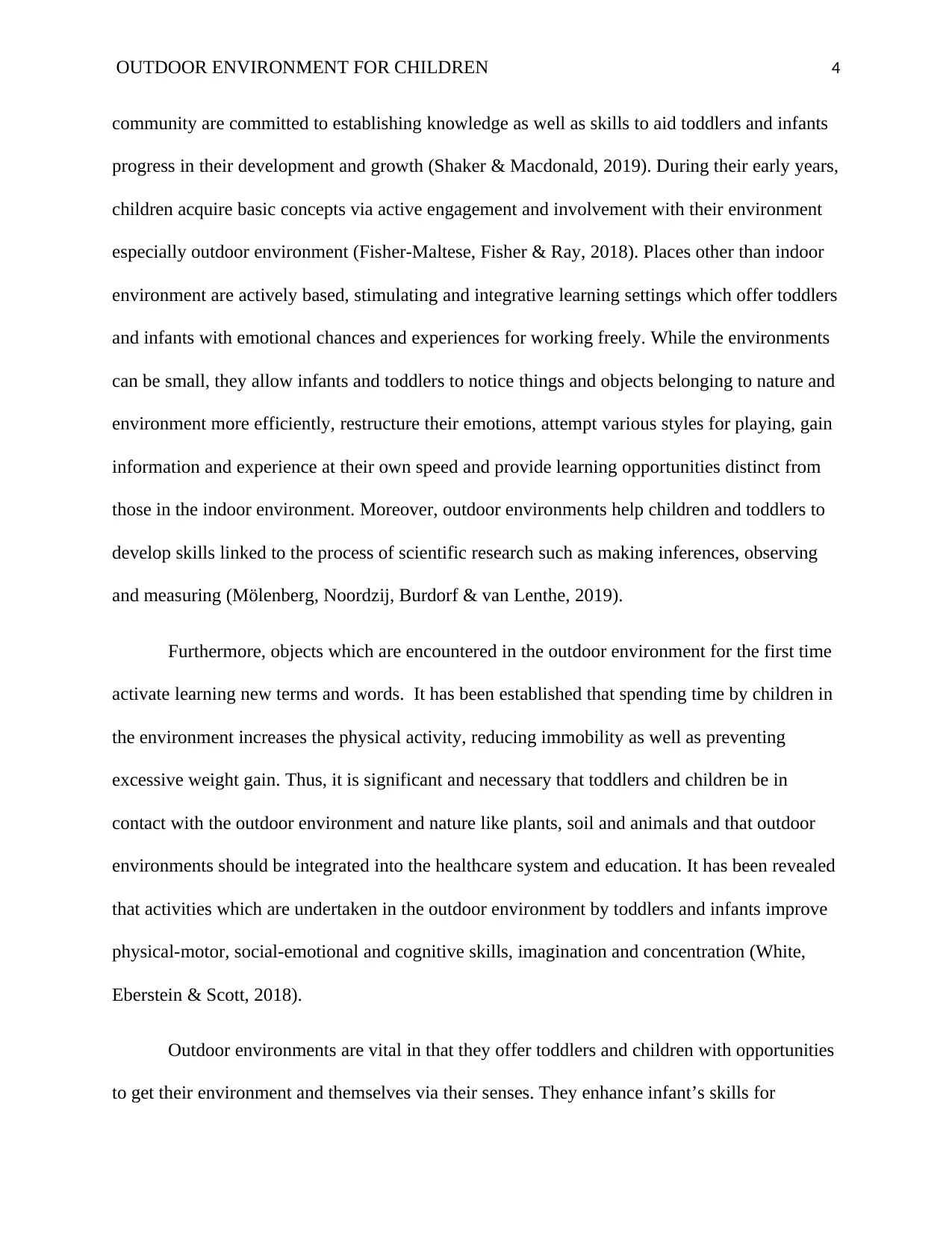
OUTDOOR ENVIRONMENT FOR CHILDREN 4
community are committed to establishing knowledge as well as skills to aid toddlers and infants
progress in their development and growth (Shaker & Macdonald, 2019). During their early years,
children acquire basic concepts via active engagement and involvement with their environment
especially outdoor environment (Fisher-Maltese, Fisher & Ray, 2018). Places other than indoor
environment are actively based, stimulating and integrative learning settings which offer toddlers
and infants with emotional chances and experiences for working freely. While the environments
can be small, they allow infants and toddlers to notice things and objects belonging to nature and
environment more efficiently, restructure their emotions, attempt various styles for playing, gain
information and experience at their own speed and provide learning opportunities distinct from
those in the indoor environment. Moreover, outdoor environments help children and toddlers to
develop skills linked to the process of scientific research such as making inferences, observing
and measuring (Mölenberg, Noordzij, Burdorf & van Lenthe, 2019).
Furthermore, objects which are encountered in the outdoor environment for the first time
activate learning new terms and words. It has been established that spending time by children in
the environment increases the physical activity, reducing immobility as well as preventing
excessive weight gain. Thus, it is significant and necessary that toddlers and children be in
contact with the outdoor environment and nature like plants, soil and animals and that outdoor
environments should be integrated into the healthcare system and education. It has been revealed
that activities which are undertaken in the outdoor environment by toddlers and infants improve
physical-motor, social-emotional and cognitive skills, imagination and concentration (White,
Eberstein & Scott, 2018).
Outdoor environments are vital in that they offer toddlers and children with opportunities
to get their environment and themselves via their senses. They enhance infant’s skills for
community are committed to establishing knowledge as well as skills to aid toddlers and infants
progress in their development and growth (Shaker & Macdonald, 2019). During their early years,
children acquire basic concepts via active engagement and involvement with their environment
especially outdoor environment (Fisher-Maltese, Fisher & Ray, 2018). Places other than indoor
environment are actively based, stimulating and integrative learning settings which offer toddlers
and infants with emotional chances and experiences for working freely. While the environments
can be small, they allow infants and toddlers to notice things and objects belonging to nature and
environment more efficiently, restructure their emotions, attempt various styles for playing, gain
information and experience at their own speed and provide learning opportunities distinct from
those in the indoor environment. Moreover, outdoor environments help children and toddlers to
develop skills linked to the process of scientific research such as making inferences, observing
and measuring (Mölenberg, Noordzij, Burdorf & van Lenthe, 2019).
Furthermore, objects which are encountered in the outdoor environment for the first time
activate learning new terms and words. It has been established that spending time by children in
the environment increases the physical activity, reducing immobility as well as preventing
excessive weight gain. Thus, it is significant and necessary that toddlers and children be in
contact with the outdoor environment and nature like plants, soil and animals and that outdoor
environments should be integrated into the healthcare system and education. It has been revealed
that activities which are undertaken in the outdoor environment by toddlers and infants improve
physical-motor, social-emotional and cognitive skills, imagination and concentration (White,
Eberstein & Scott, 2018).
Outdoor environments are vital in that they offer toddlers and children with opportunities
to get their environment and themselves via their senses. They enhance infant’s skills for
Paraphrase This Document
Need a fresh take? Get an instant paraphrase of this document with our AI Paraphraser
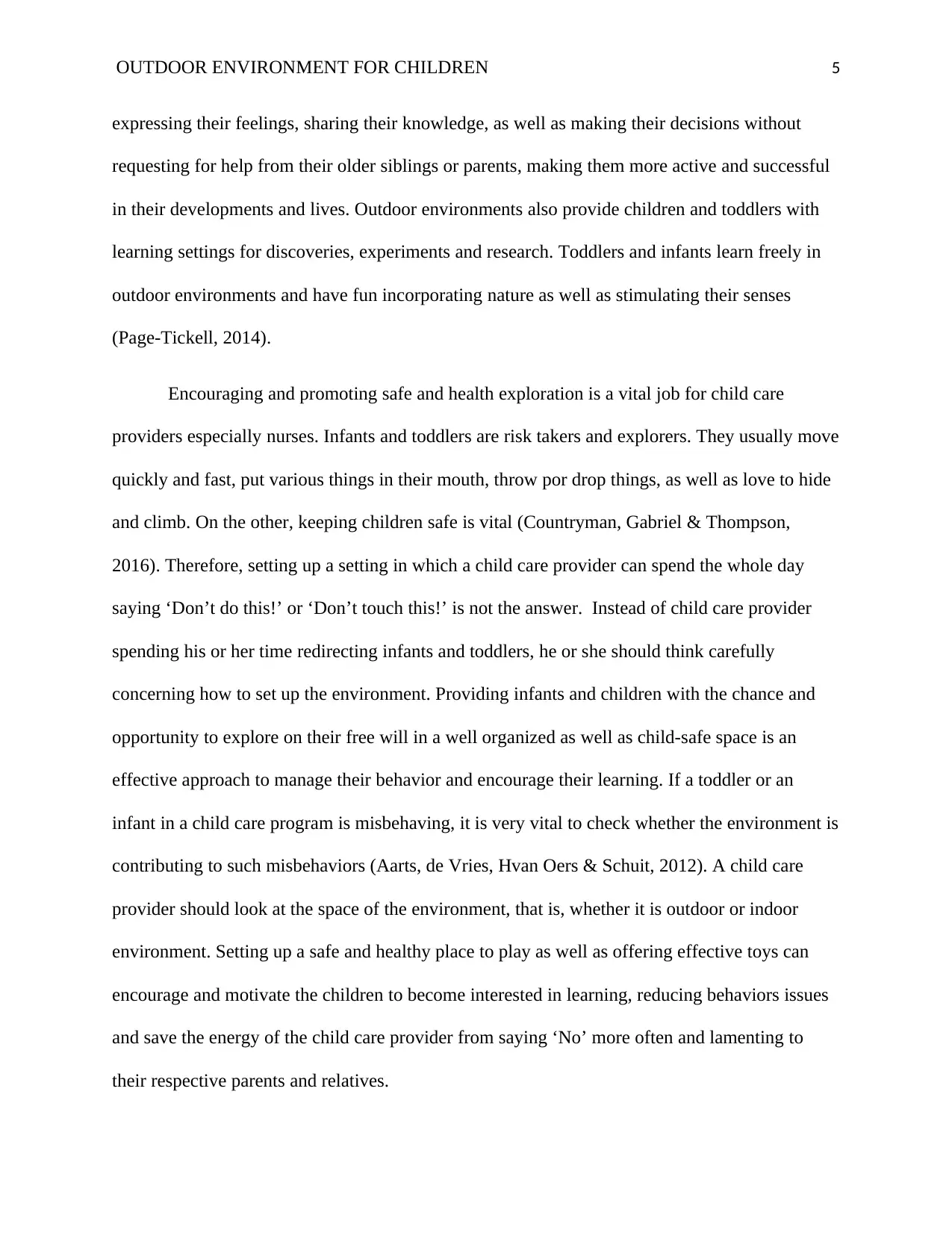
OUTDOOR ENVIRONMENT FOR CHILDREN 5
expressing their feelings, sharing their knowledge, as well as making their decisions without
requesting for help from their older siblings or parents, making them more active and successful
in their developments and lives. Outdoor environments also provide children and toddlers with
learning settings for discoveries, experiments and research. Toddlers and infants learn freely in
outdoor environments and have fun incorporating nature as well as stimulating their senses
(Page-Tickell, 2014).
Encouraging and promoting safe and health exploration is a vital job for child care
providers especially nurses. Infants and toddlers are risk takers and explorers. They usually move
quickly and fast, put various things in their mouth, throw por drop things, as well as love to hide
and climb. On the other, keeping children safe is vital (Countryman, Gabriel & Thompson,
2016). Therefore, setting up a setting in which a child care provider can spend the whole day
saying ‘Don’t do this!’ or ‘Don’t touch this!’ is not the answer. Instead of child care provider
spending his or her time redirecting infants and toddlers, he or she should think carefully
concerning how to set up the environment. Providing infants and children with the chance and
opportunity to explore on their free will in a well organized as well as child-safe space is an
effective approach to manage their behavior and encourage their learning. If a toddler or an
infant in a child care program is misbehaving, it is very vital to check whether the environment is
contributing to such misbehaviors (Aarts, de Vries, Hvan Oers & Schuit, 2012). A child care
provider should look at the space of the environment, that is, whether it is outdoor or indoor
environment. Setting up a safe and healthy place to play as well as offering effective toys can
encourage and motivate the children to become interested in learning, reducing behaviors issues
and save the energy of the child care provider from saying ‘No’ more often and lamenting to
their respective parents and relatives.
expressing their feelings, sharing their knowledge, as well as making their decisions without
requesting for help from their older siblings or parents, making them more active and successful
in their developments and lives. Outdoor environments also provide children and toddlers with
learning settings for discoveries, experiments and research. Toddlers and infants learn freely in
outdoor environments and have fun incorporating nature as well as stimulating their senses
(Page-Tickell, 2014).
Encouraging and promoting safe and health exploration is a vital job for child care
providers especially nurses. Infants and toddlers are risk takers and explorers. They usually move
quickly and fast, put various things in their mouth, throw por drop things, as well as love to hide
and climb. On the other, keeping children safe is vital (Countryman, Gabriel & Thompson,
2016). Therefore, setting up a setting in which a child care provider can spend the whole day
saying ‘Don’t do this!’ or ‘Don’t touch this!’ is not the answer. Instead of child care provider
spending his or her time redirecting infants and toddlers, he or she should think carefully
concerning how to set up the environment. Providing infants and children with the chance and
opportunity to explore on their free will in a well organized as well as child-safe space is an
effective approach to manage their behavior and encourage their learning. If a toddler or an
infant in a child care program is misbehaving, it is very vital to check whether the environment is
contributing to such misbehaviors (Aarts, de Vries, Hvan Oers & Schuit, 2012). A child care
provider should look at the space of the environment, that is, whether it is outdoor or indoor
environment. Setting up a safe and healthy place to play as well as offering effective toys can
encourage and motivate the children to become interested in learning, reducing behaviors issues
and save the energy of the child care provider from saying ‘No’ more often and lamenting to
their respective parents and relatives.
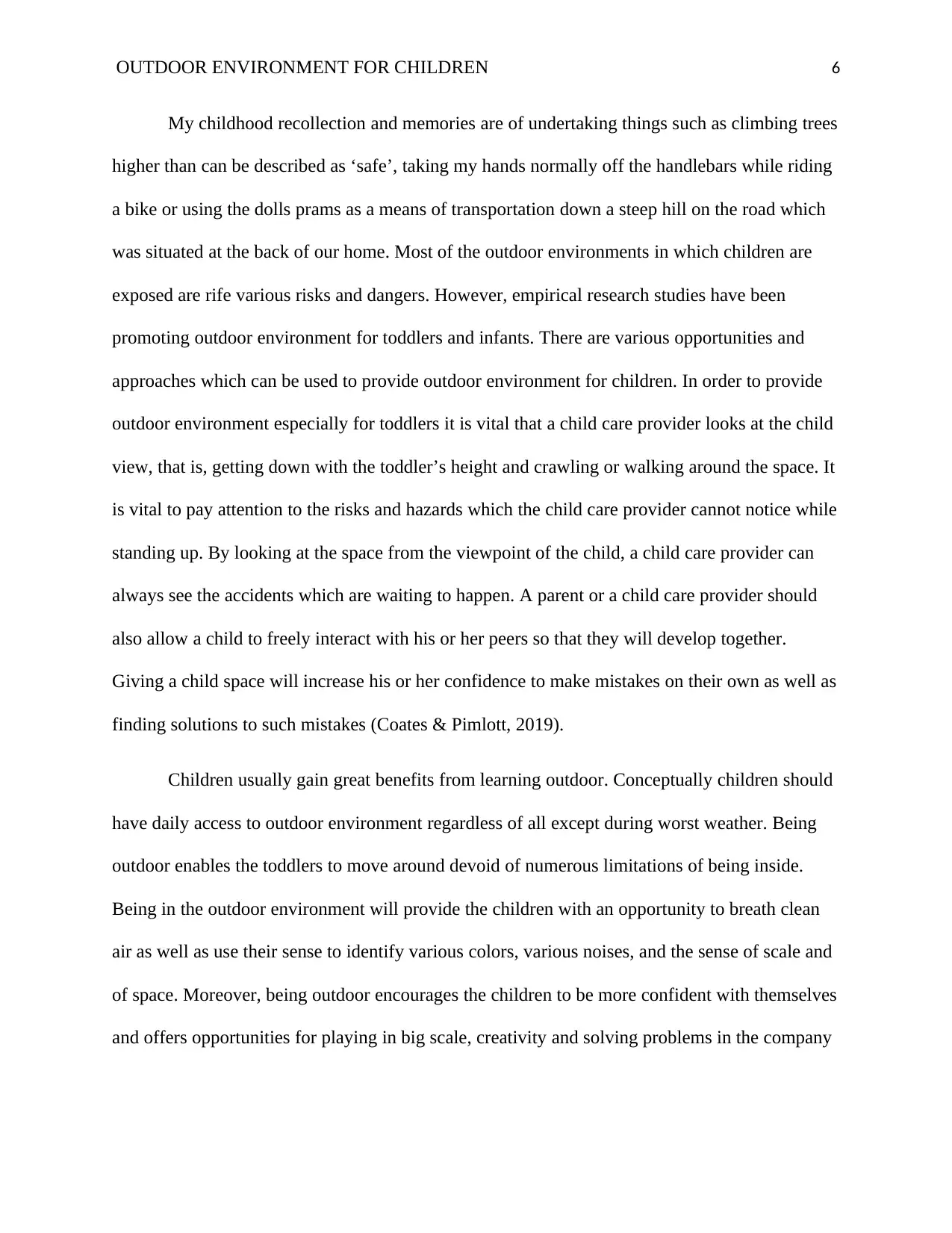
OUTDOOR ENVIRONMENT FOR CHILDREN 6
My childhood recollection and memories are of undertaking things such as climbing trees
higher than can be described as ‘safe’, taking my hands normally off the handlebars while riding
a bike or using the dolls prams as a means of transportation down a steep hill on the road which
was situated at the back of our home. Most of the outdoor environments in which children are
exposed are rife various risks and dangers. However, empirical research studies have been
promoting outdoor environment for toddlers and infants. There are various opportunities and
approaches which can be used to provide outdoor environment for children. In order to provide
outdoor environment especially for toddlers it is vital that a child care provider looks at the child
view, that is, getting down with the toddler’s height and crawling or walking around the space. It
is vital to pay attention to the risks and hazards which the child care provider cannot notice while
standing up. By looking at the space from the viewpoint of the child, a child care provider can
always see the accidents which are waiting to happen. A parent or a child care provider should
also allow a child to freely interact with his or her peers so that they will develop together.
Giving a child space will increase his or her confidence to make mistakes on their own as well as
finding solutions to such mistakes (Coates & Pimlott, 2019).
Children usually gain great benefits from learning outdoor. Conceptually children should
have daily access to outdoor environment regardless of all except during worst weather. Being
outdoor enables the toddlers to move around devoid of numerous limitations of being inside.
Being in the outdoor environment will provide the children with an opportunity to breath clean
air as well as use their sense to identify various colors, various noises, and the sense of scale and
of space. Moreover, being outdoor encourages the children to be more confident with themselves
and offers opportunities for playing in big scale, creativity and solving problems in the company
My childhood recollection and memories are of undertaking things such as climbing trees
higher than can be described as ‘safe’, taking my hands normally off the handlebars while riding
a bike or using the dolls prams as a means of transportation down a steep hill on the road which
was situated at the back of our home. Most of the outdoor environments in which children are
exposed are rife various risks and dangers. However, empirical research studies have been
promoting outdoor environment for toddlers and infants. There are various opportunities and
approaches which can be used to provide outdoor environment for children. In order to provide
outdoor environment especially for toddlers it is vital that a child care provider looks at the child
view, that is, getting down with the toddler’s height and crawling or walking around the space. It
is vital to pay attention to the risks and hazards which the child care provider cannot notice while
standing up. By looking at the space from the viewpoint of the child, a child care provider can
always see the accidents which are waiting to happen. A parent or a child care provider should
also allow a child to freely interact with his or her peers so that they will develop together.
Giving a child space will increase his or her confidence to make mistakes on their own as well as
finding solutions to such mistakes (Coates & Pimlott, 2019).
Children usually gain great benefits from learning outdoor. Conceptually children should
have daily access to outdoor environment regardless of all except during worst weather. Being
outdoor enables the toddlers to move around devoid of numerous limitations of being inside.
Being in the outdoor environment will provide the children with an opportunity to breath clean
air as well as use their sense to identify various colors, various noises, and the sense of scale and
of space. Moreover, being outdoor encourages the children to be more confident with themselves
and offers opportunities for playing in big scale, creativity and solving problems in the company
⊘ This is a preview!⊘
Do you want full access?
Subscribe today to unlock all pages.

Trusted by 1+ million students worldwide
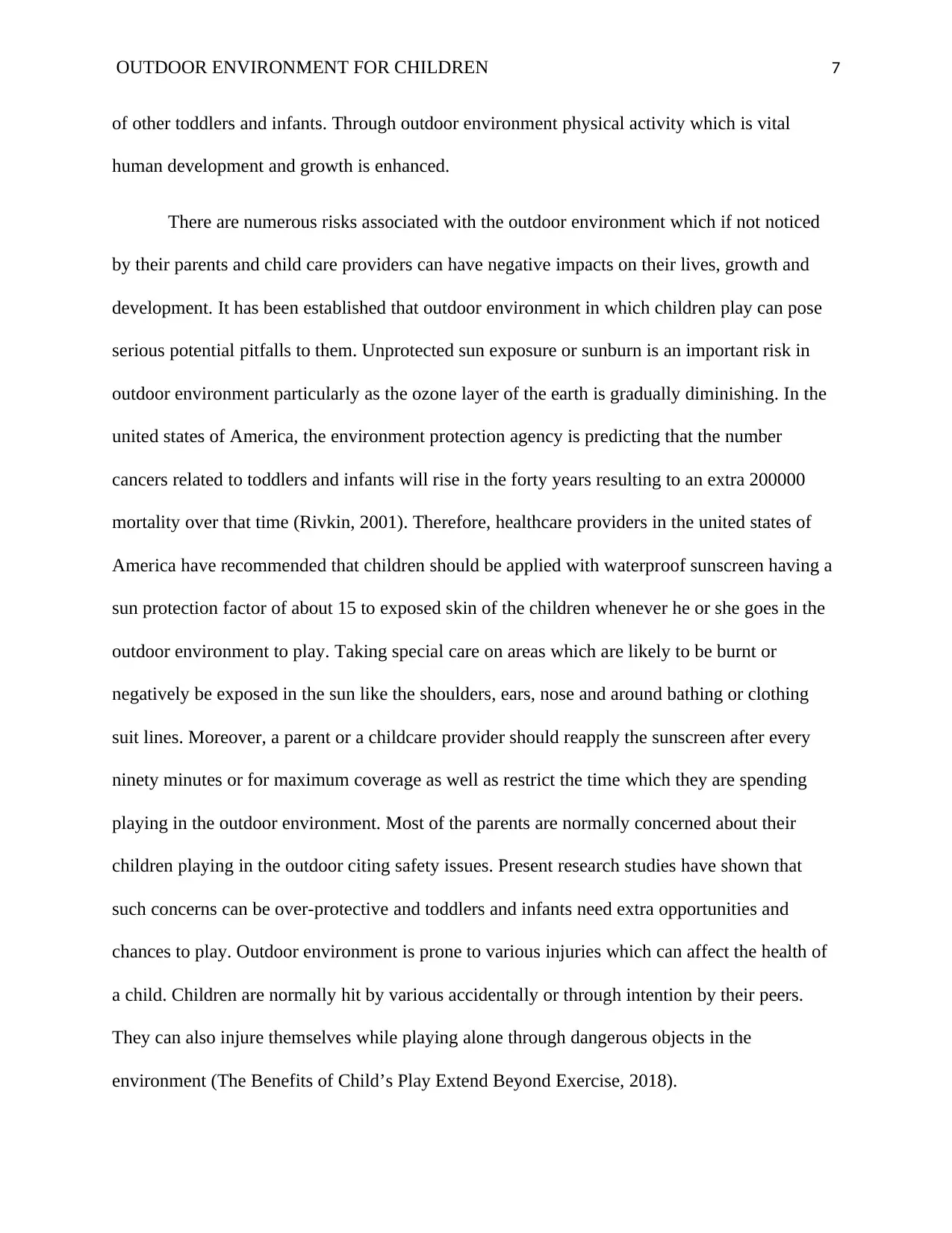
OUTDOOR ENVIRONMENT FOR CHILDREN 7
of other toddlers and infants. Through outdoor environment physical activity which is vital
human development and growth is enhanced.
There are numerous risks associated with the outdoor environment which if not noticed
by their parents and child care providers can have negative impacts on their lives, growth and
development. It has been established that outdoor environment in which children play can pose
serious potential pitfalls to them. Unprotected sun exposure or sunburn is an important risk in
outdoor environment particularly as the ozone layer of the earth is gradually diminishing. In the
united states of America, the environment protection agency is predicting that the number
cancers related to toddlers and infants will rise in the forty years resulting to an extra 200000
mortality over that time (Rivkin, 2001). Therefore, healthcare providers in the united states of
America have recommended that children should be applied with waterproof sunscreen having a
sun protection factor of about 15 to exposed skin of the children whenever he or she goes in the
outdoor environment to play. Taking special care on areas which are likely to be burnt or
negatively be exposed in the sun like the shoulders, ears, nose and around bathing or clothing
suit lines. Moreover, a parent or a childcare provider should reapply the sunscreen after every
ninety minutes or for maximum coverage as well as restrict the time which they are spending
playing in the outdoor environment. Most of the parents are normally concerned about their
children playing in the outdoor citing safety issues. Present research studies have shown that
such concerns can be over-protective and toddlers and infants need extra opportunities and
chances to play. Outdoor environment is prone to various injuries which can affect the health of
a child. Children are normally hit by various accidentally or through intention by their peers.
They can also injure themselves while playing alone through dangerous objects in the
environment (The Benefits of Child’s Play Extend Beyond Exercise, 2018).
of other toddlers and infants. Through outdoor environment physical activity which is vital
human development and growth is enhanced.
There are numerous risks associated with the outdoor environment which if not noticed
by their parents and child care providers can have negative impacts on their lives, growth and
development. It has been established that outdoor environment in which children play can pose
serious potential pitfalls to them. Unprotected sun exposure or sunburn is an important risk in
outdoor environment particularly as the ozone layer of the earth is gradually diminishing. In the
united states of America, the environment protection agency is predicting that the number
cancers related to toddlers and infants will rise in the forty years resulting to an extra 200000
mortality over that time (Rivkin, 2001). Therefore, healthcare providers in the united states of
America have recommended that children should be applied with waterproof sunscreen having a
sun protection factor of about 15 to exposed skin of the children whenever he or she goes in the
outdoor environment to play. Taking special care on areas which are likely to be burnt or
negatively be exposed in the sun like the shoulders, ears, nose and around bathing or clothing
suit lines. Moreover, a parent or a childcare provider should reapply the sunscreen after every
ninety minutes or for maximum coverage as well as restrict the time which they are spending
playing in the outdoor environment. Most of the parents are normally concerned about their
children playing in the outdoor citing safety issues. Present research studies have shown that
such concerns can be over-protective and toddlers and infants need extra opportunities and
chances to play. Outdoor environment is prone to various injuries which can affect the health of
a child. Children are normally hit by various accidentally or through intention by their peers.
They can also injure themselves while playing alone through dangerous objects in the
environment (The Benefits of Child’s Play Extend Beyond Exercise, 2018).
Paraphrase This Document
Need a fresh take? Get an instant paraphrase of this document with our AI Paraphraser
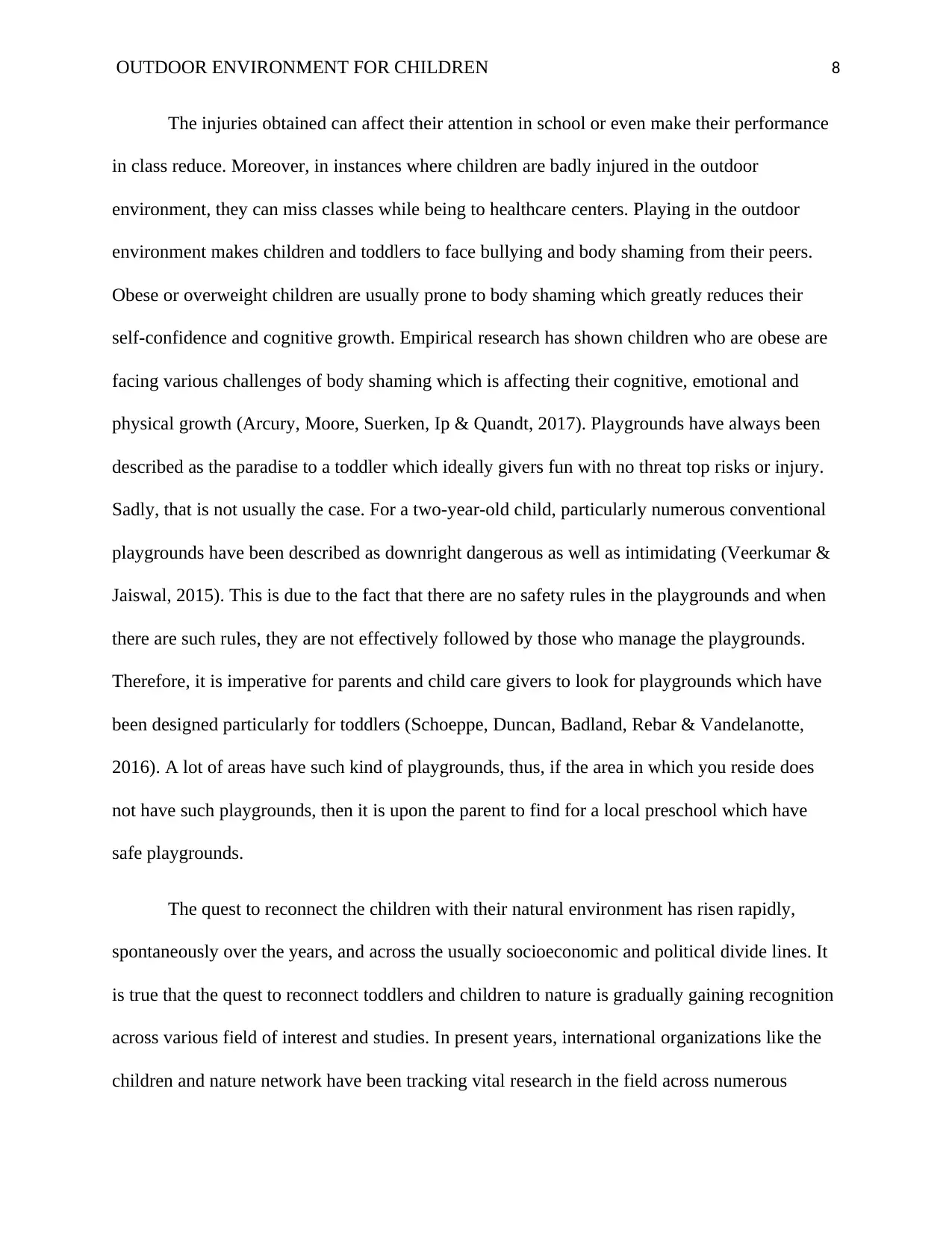
OUTDOOR ENVIRONMENT FOR CHILDREN 8
The injuries obtained can affect their attention in school or even make their performance
in class reduce. Moreover, in instances where children are badly injured in the outdoor
environment, they can miss classes while being to healthcare centers. Playing in the outdoor
environment makes children and toddlers to face bullying and body shaming from their peers.
Obese or overweight children are usually prone to body shaming which greatly reduces their
self-confidence and cognitive growth. Empirical research has shown children who are obese are
facing various challenges of body shaming which is affecting their cognitive, emotional and
physical growth (Arcury, Moore, Suerken, Ip & Quandt, 2017). Playgrounds have always been
described as the paradise to a toddler which ideally givers fun with no threat top risks or injury.
Sadly, that is not usually the case. For a two-year-old child, particularly numerous conventional
playgrounds have been described as downright dangerous as well as intimidating (Veerkumar &
Jaiswal, 2015). This is due to the fact that there are no safety rules in the playgrounds and when
there are such rules, they are not effectively followed by those who manage the playgrounds.
Therefore, it is imperative for parents and child care givers to look for playgrounds which have
been designed particularly for toddlers (Schoeppe, Duncan, Badland, Rebar & Vandelanotte,
2016). A lot of areas have such kind of playgrounds, thus, if the area in which you reside does
not have such playgrounds, then it is upon the parent to find for a local preschool which have
safe playgrounds.
The quest to reconnect the children with their natural environment has risen rapidly,
spontaneously over the years, and across the usually socioeconomic and political divide lines. It
is true that the quest to reconnect toddlers and children to nature is gradually gaining recognition
across various field of interest and studies. In present years, international organizations like the
children and nature network have been tracking vital research in the field across numerous
The injuries obtained can affect their attention in school or even make their performance
in class reduce. Moreover, in instances where children are badly injured in the outdoor
environment, they can miss classes while being to healthcare centers. Playing in the outdoor
environment makes children and toddlers to face bullying and body shaming from their peers.
Obese or overweight children are usually prone to body shaming which greatly reduces their
self-confidence and cognitive growth. Empirical research has shown children who are obese are
facing various challenges of body shaming which is affecting their cognitive, emotional and
physical growth (Arcury, Moore, Suerken, Ip & Quandt, 2017). Playgrounds have always been
described as the paradise to a toddler which ideally givers fun with no threat top risks or injury.
Sadly, that is not usually the case. For a two-year-old child, particularly numerous conventional
playgrounds have been described as downright dangerous as well as intimidating (Veerkumar &
Jaiswal, 2015). This is due to the fact that there are no safety rules in the playgrounds and when
there are such rules, they are not effectively followed by those who manage the playgrounds.
Therefore, it is imperative for parents and child care givers to look for playgrounds which have
been designed particularly for toddlers (Schoeppe, Duncan, Badland, Rebar & Vandelanotte,
2016). A lot of areas have such kind of playgrounds, thus, if the area in which you reside does
not have such playgrounds, then it is upon the parent to find for a local preschool which have
safe playgrounds.
The quest to reconnect the children with their natural environment has risen rapidly,
spontaneously over the years, and across the usually socioeconomic and political divide lines. It
is true that the quest to reconnect toddlers and children to nature is gradually gaining recognition
across various field of interest and studies. In present years, international organizations like the
children and nature network have been tracking vital research in the field across numerous
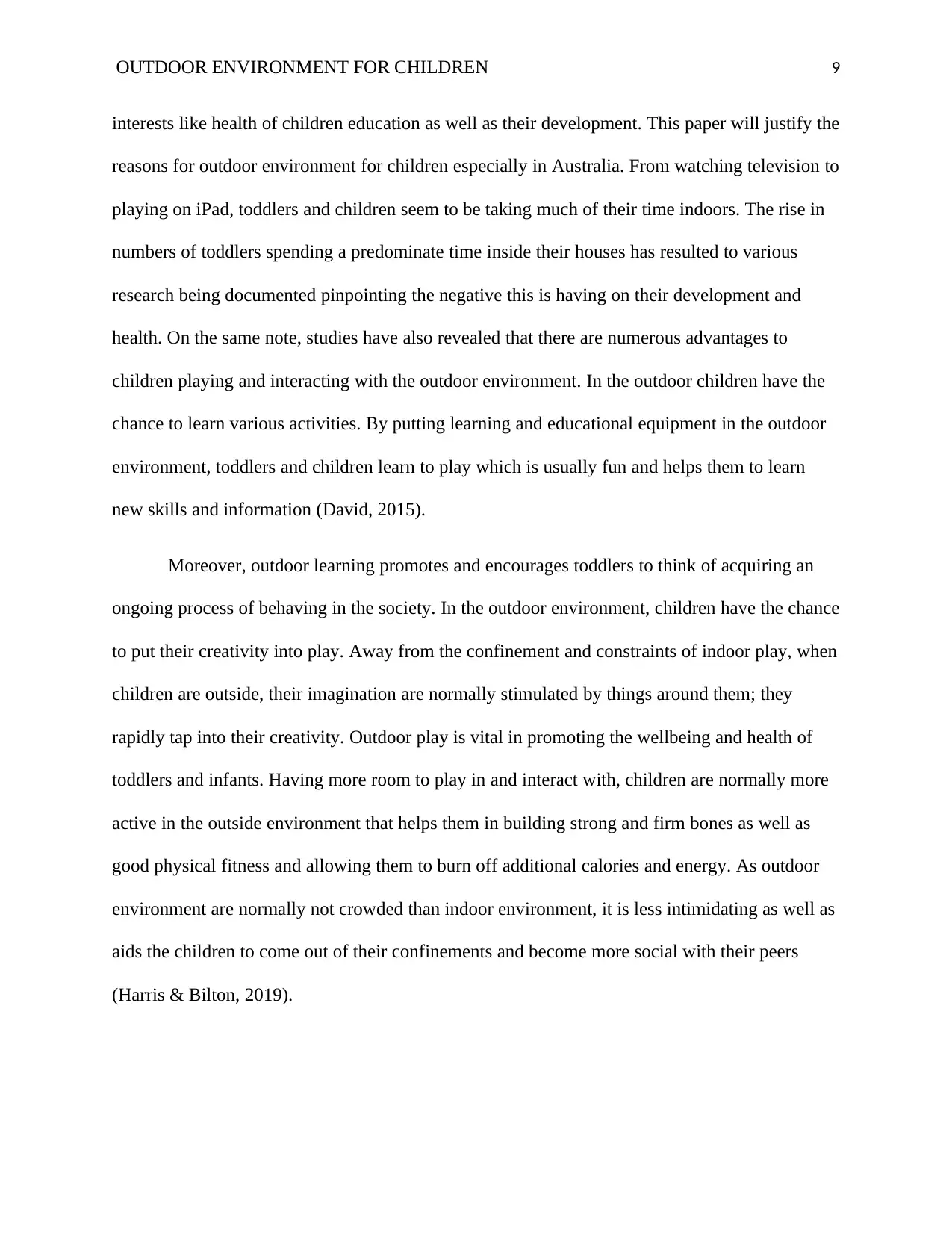
OUTDOOR ENVIRONMENT FOR CHILDREN 9
interests like health of children education as well as their development. This paper will justify the
reasons for outdoor environment for children especially in Australia. From watching television to
playing on iPad, toddlers and children seem to be taking much of their time indoors. The rise in
numbers of toddlers spending a predominate time inside their houses has resulted to various
research being documented pinpointing the negative this is having on their development and
health. On the same note, studies have also revealed that there are numerous advantages to
children playing and interacting with the outdoor environment. In the outdoor children have the
chance to learn various activities. By putting learning and educational equipment in the outdoor
environment, toddlers and children learn to play which is usually fun and helps them to learn
new skills and information (David, 2015).
Moreover, outdoor learning promotes and encourages toddlers to think of acquiring an
ongoing process of behaving in the society. In the outdoor environment, children have the chance
to put their creativity into play. Away from the confinement and constraints of indoor play, when
children are outside, their imagination are normally stimulated by things around them; they
rapidly tap into their creativity. Outdoor play is vital in promoting the wellbeing and health of
toddlers and infants. Having more room to play in and interact with, children are normally more
active in the outside environment that helps them in building strong and firm bones as well as
good physical fitness and allowing them to burn off additional calories and energy. As outdoor
environment are normally not crowded than indoor environment, it is less intimidating as well as
aids the children to come out of their confinements and become more social with their peers
(Harris & Bilton, 2019).
interests like health of children education as well as their development. This paper will justify the
reasons for outdoor environment for children especially in Australia. From watching television to
playing on iPad, toddlers and children seem to be taking much of their time indoors. The rise in
numbers of toddlers spending a predominate time inside their houses has resulted to various
research being documented pinpointing the negative this is having on their development and
health. On the same note, studies have also revealed that there are numerous advantages to
children playing and interacting with the outdoor environment. In the outdoor children have the
chance to learn various activities. By putting learning and educational equipment in the outdoor
environment, toddlers and children learn to play which is usually fun and helps them to learn
new skills and information (David, 2015).
Moreover, outdoor learning promotes and encourages toddlers to think of acquiring an
ongoing process of behaving in the society. In the outdoor environment, children have the chance
to put their creativity into play. Away from the confinement and constraints of indoor play, when
children are outside, their imagination are normally stimulated by things around them; they
rapidly tap into their creativity. Outdoor play is vital in promoting the wellbeing and health of
toddlers and infants. Having more room to play in and interact with, children are normally more
active in the outside environment that helps them in building strong and firm bones as well as
good physical fitness and allowing them to burn off additional calories and energy. As outdoor
environment are normally not crowded than indoor environment, it is less intimidating as well as
aids the children to come out of their confinements and become more social with their peers
(Harris & Bilton, 2019).
⊘ This is a preview!⊘
Do you want full access?
Subscribe today to unlock all pages.

Trusted by 1+ million students worldwide
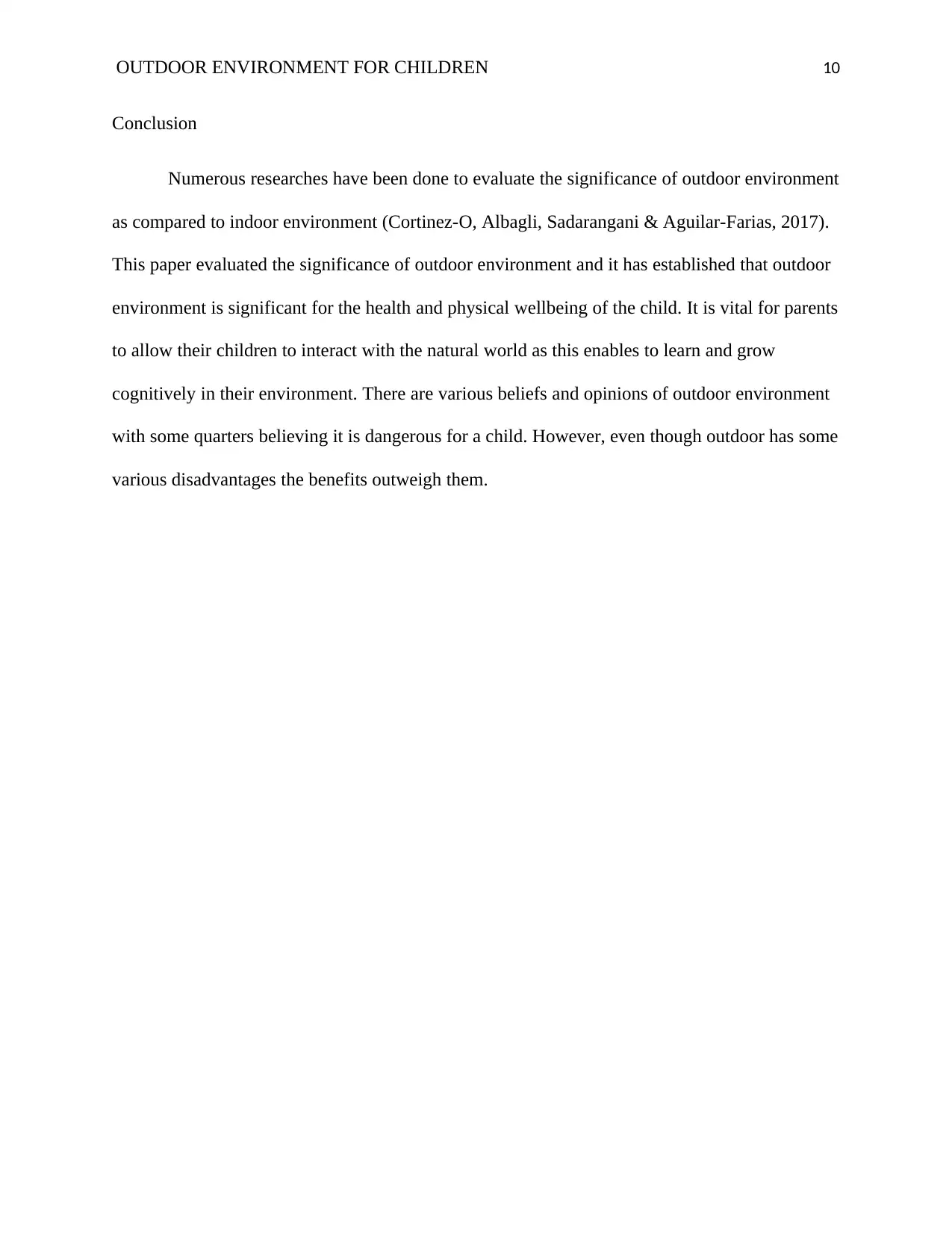
OUTDOOR ENVIRONMENT FOR CHILDREN 10
Conclusion
Numerous researches have been done to evaluate the significance of outdoor environment
as compared to indoor environment (Cortinez-O, Albagli, Sadarangani & Aguilar-Farias, 2017).
This paper evaluated the significance of outdoor environment and it has established that outdoor
environment is significant for the health and physical wellbeing of the child. It is vital for parents
to allow their children to interact with the natural world as this enables to learn and grow
cognitively in their environment. There are various beliefs and opinions of outdoor environment
with some quarters believing it is dangerous for a child. However, even though outdoor has some
various disadvantages the benefits outweigh them.
Conclusion
Numerous researches have been done to evaluate the significance of outdoor environment
as compared to indoor environment (Cortinez-O, Albagli, Sadarangani & Aguilar-Farias, 2017).
This paper evaluated the significance of outdoor environment and it has established that outdoor
environment is significant for the health and physical wellbeing of the child. It is vital for parents
to allow their children to interact with the natural world as this enables to learn and grow
cognitively in their environment. There are various beliefs and opinions of outdoor environment
with some quarters believing it is dangerous for a child. However, even though outdoor has some
various disadvantages the benefits outweigh them.
Paraphrase This Document
Need a fresh take? Get an instant paraphrase of this document with our AI Paraphraser
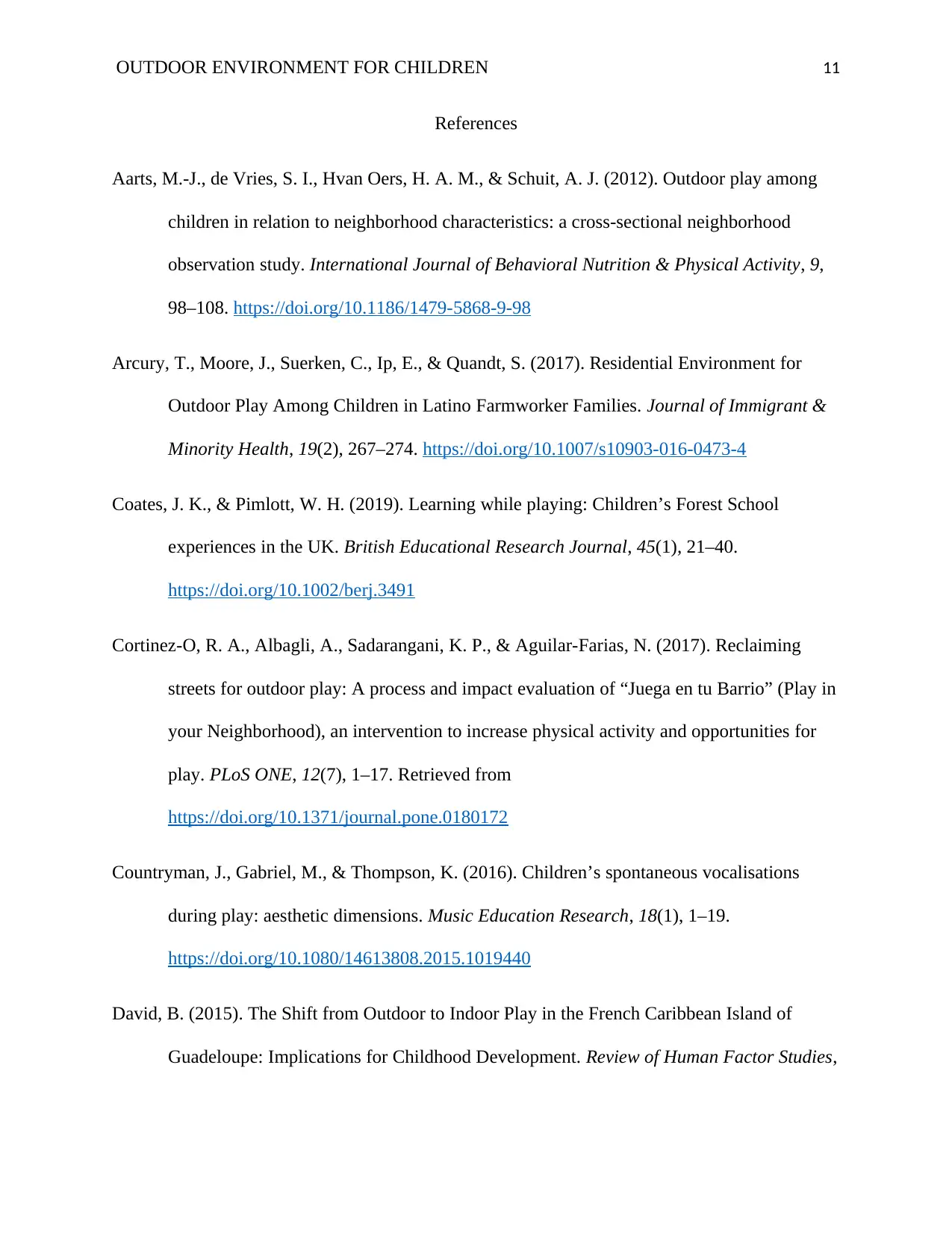
OUTDOOR ENVIRONMENT FOR CHILDREN 11
References
Aarts, M.-J., de Vries, S. I., Hvan Oers, H. A. M., & Schuit, A. J. (2012). Outdoor play among
children in relation to neighborhood characteristics: a cross-sectional neighborhood
observation study. International Journal of Behavioral Nutrition & Physical Activity, 9,
98–108. https://doi.org/10.1186/1479-5868-9-98
Arcury, T., Moore, J., Suerken, C., Ip, E., & Quandt, S. (2017). Residential Environment for
Outdoor Play Among Children in Latino Farmworker Families. Journal of Immigrant &
Minority Health, 19(2), 267–274. https://doi.org/10.1007/s10903-016-0473-4
Coates, J. K., & Pimlott, W. H. (2019). Learning while playing: Children’s Forest School
experiences in the UK. British Educational Research Journal, 45(1), 21–40.
https://doi.org/10.1002/berj.3491
Cortinez-O, R. A., Albagli, A., Sadarangani, K. P., & Aguilar-Farias, N. (2017). Reclaiming
streets for outdoor play: A process and impact evaluation of “Juega en tu Barrio” (Play in
your Neighborhood), an intervention to increase physical activity and opportunities for
play. PLoS ONE, 12(7), 1–17. Retrieved from
https://doi.org/10.1371/journal.pone.0180172
Countryman, J., Gabriel, M., & Thompson, K. (2016). Children’s spontaneous vocalisations
during play: aesthetic dimensions. Music Education Research, 18(1), 1–19.
https://doi.org/10.1080/14613808.2015.1019440
David, B. (2015). The Shift from Outdoor to Indoor Play in the French Caribbean Island of
Guadeloupe: Implications for Childhood Development. Review of Human Factor Studies,
References
Aarts, M.-J., de Vries, S. I., Hvan Oers, H. A. M., & Schuit, A. J. (2012). Outdoor play among
children in relation to neighborhood characteristics: a cross-sectional neighborhood
observation study. International Journal of Behavioral Nutrition & Physical Activity, 9,
98–108. https://doi.org/10.1186/1479-5868-9-98
Arcury, T., Moore, J., Suerken, C., Ip, E., & Quandt, S. (2017). Residential Environment for
Outdoor Play Among Children in Latino Farmworker Families. Journal of Immigrant &
Minority Health, 19(2), 267–274. https://doi.org/10.1007/s10903-016-0473-4
Coates, J. K., & Pimlott, W. H. (2019). Learning while playing: Children’s Forest School
experiences in the UK. British Educational Research Journal, 45(1), 21–40.
https://doi.org/10.1002/berj.3491
Cortinez-O, R. A., Albagli, A., Sadarangani, K. P., & Aguilar-Farias, N. (2017). Reclaiming
streets for outdoor play: A process and impact evaluation of “Juega en tu Barrio” (Play in
your Neighborhood), an intervention to increase physical activity and opportunities for
play. PLoS ONE, 12(7), 1–17. Retrieved from
https://doi.org/10.1371/journal.pone.0180172
Countryman, J., Gabriel, M., & Thompson, K. (2016). Children’s spontaneous vocalisations
during play: aesthetic dimensions. Music Education Research, 18(1), 1–19.
https://doi.org/10.1080/14613808.2015.1019440
David, B. (2015). The Shift from Outdoor to Indoor Play in the French Caribbean Island of
Guadeloupe: Implications for Childhood Development. Review of Human Factor Studies,
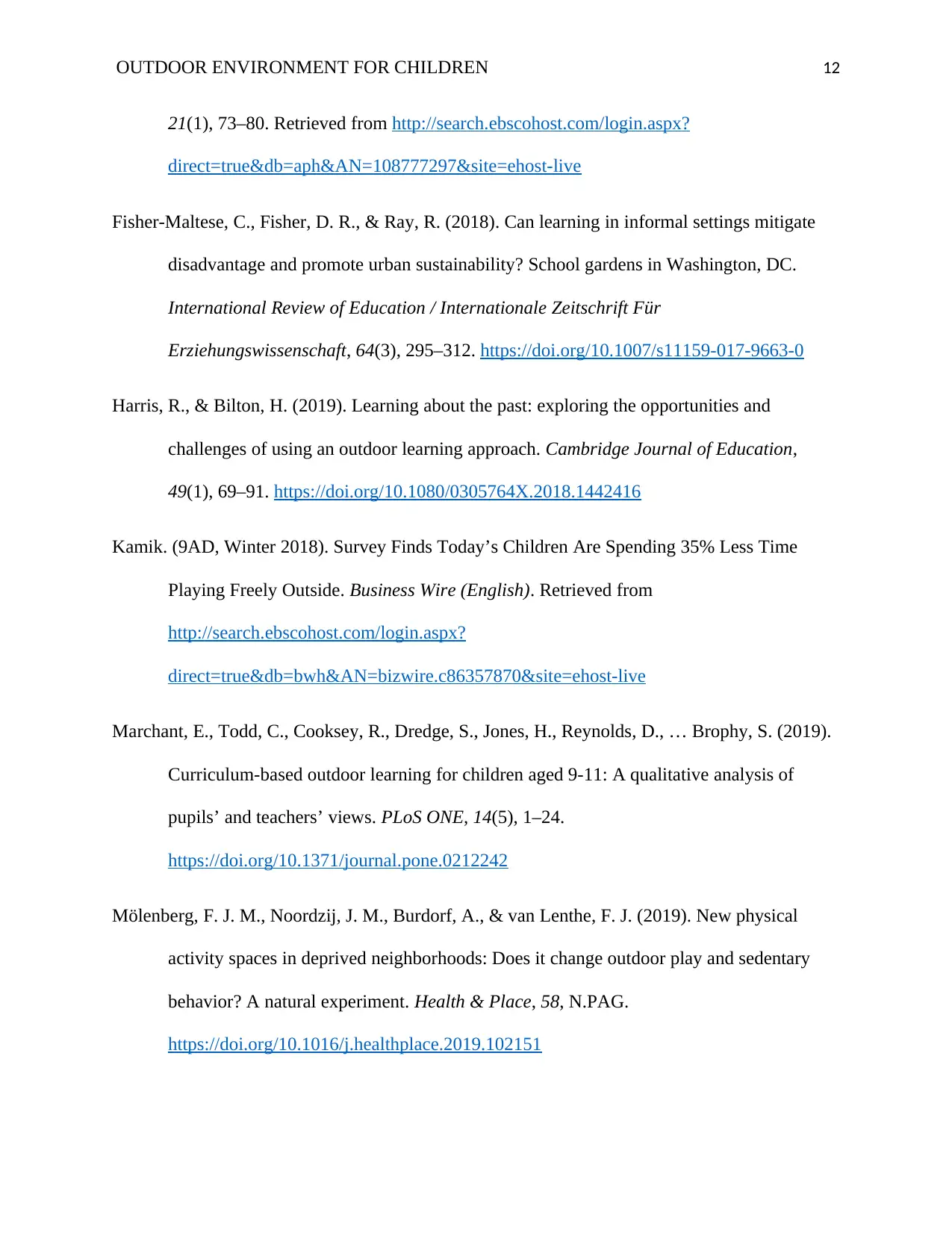
OUTDOOR ENVIRONMENT FOR CHILDREN 12
21(1), 73–80. Retrieved from http://search.ebscohost.com/login.aspx?
direct=true&db=aph&AN=108777297&site=ehost-live
Fisher-Maltese, C., Fisher, D. R., & Ray, R. (2018). Can learning in informal settings mitigate
disadvantage and promote urban sustainability? School gardens in Washington, DC.
International Review of Education / Internationale Zeitschrift Für
Erziehungswissenschaft, 64(3), 295–312. https://doi.org/10.1007/s11159-017-9663-0
Harris, R., & Bilton, H. (2019). Learning about the past: exploring the opportunities and
challenges of using an outdoor learning approach. Cambridge Journal of Education,
49(1), 69–91. https://doi.org/10.1080/0305764X.2018.1442416
Kamik. (9AD, Winter 2018). Survey Finds Today’s Children Are Spending 35% Less Time
Playing Freely Outside. Business Wire (English). Retrieved from
http://search.ebscohost.com/login.aspx?
direct=true&db=bwh&AN=bizwire.c86357870&site=ehost-live
Marchant, E., Todd, C., Cooksey, R., Dredge, S., Jones, H., Reynolds, D., … Brophy, S. (2019).
Curriculum-based outdoor learning for children aged 9-11: A qualitative analysis of
pupils’ and teachers’ views. PLoS ONE, 14(5), 1–24.
https://doi.org/10.1371/journal.pone.0212242
Mölenberg, F. J. M., Noordzij, J. M., Burdorf, A., & van Lenthe, F. J. (2019). New physical
activity spaces in deprived neighborhoods: Does it change outdoor play and sedentary
behavior? A natural experiment. Health & Place, 58, N.PAG.
https://doi.org/10.1016/j.healthplace.2019.102151
21(1), 73–80. Retrieved from http://search.ebscohost.com/login.aspx?
direct=true&db=aph&AN=108777297&site=ehost-live
Fisher-Maltese, C., Fisher, D. R., & Ray, R. (2018). Can learning in informal settings mitigate
disadvantage and promote urban sustainability? School gardens in Washington, DC.
International Review of Education / Internationale Zeitschrift Für
Erziehungswissenschaft, 64(3), 295–312. https://doi.org/10.1007/s11159-017-9663-0
Harris, R., & Bilton, H. (2019). Learning about the past: exploring the opportunities and
challenges of using an outdoor learning approach. Cambridge Journal of Education,
49(1), 69–91. https://doi.org/10.1080/0305764X.2018.1442416
Kamik. (9AD, Winter 2018). Survey Finds Today’s Children Are Spending 35% Less Time
Playing Freely Outside. Business Wire (English). Retrieved from
http://search.ebscohost.com/login.aspx?
direct=true&db=bwh&AN=bizwire.c86357870&site=ehost-live
Marchant, E., Todd, C., Cooksey, R., Dredge, S., Jones, H., Reynolds, D., … Brophy, S. (2019).
Curriculum-based outdoor learning for children aged 9-11: A qualitative analysis of
pupils’ and teachers’ views. PLoS ONE, 14(5), 1–24.
https://doi.org/10.1371/journal.pone.0212242
Mölenberg, F. J. M., Noordzij, J. M., Burdorf, A., & van Lenthe, F. J. (2019). New physical
activity spaces in deprived neighborhoods: Does it change outdoor play and sedentary
behavior? A natural experiment. Health & Place, 58, N.PAG.
https://doi.org/10.1016/j.healthplace.2019.102151
⊘ This is a preview!⊘
Do you want full access?
Subscribe today to unlock all pages.

Trusted by 1+ million students worldwide
1 out of 14
Related Documents
Your All-in-One AI-Powered Toolkit for Academic Success.
+13062052269
info@desklib.com
Available 24*7 on WhatsApp / Email
![[object Object]](/_next/static/media/star-bottom.7253800d.svg)
Unlock your academic potential
Copyright © 2020–2025 A2Z Services. All Rights Reserved. Developed and managed by ZUCOL.





